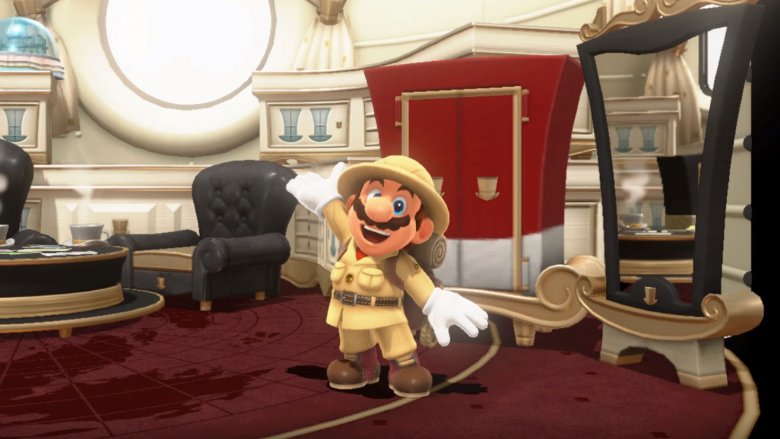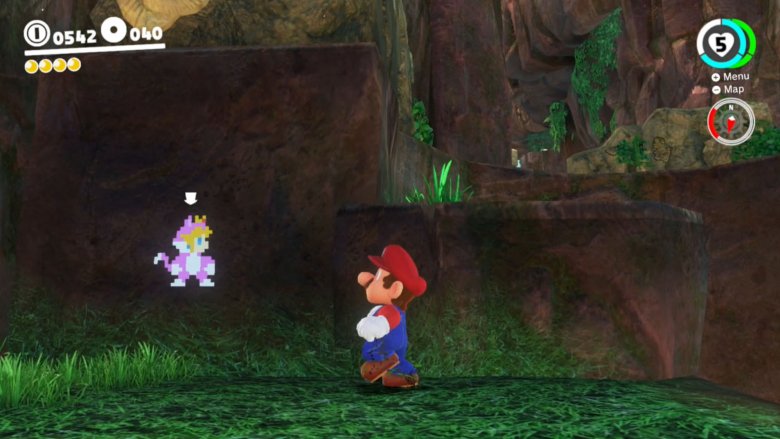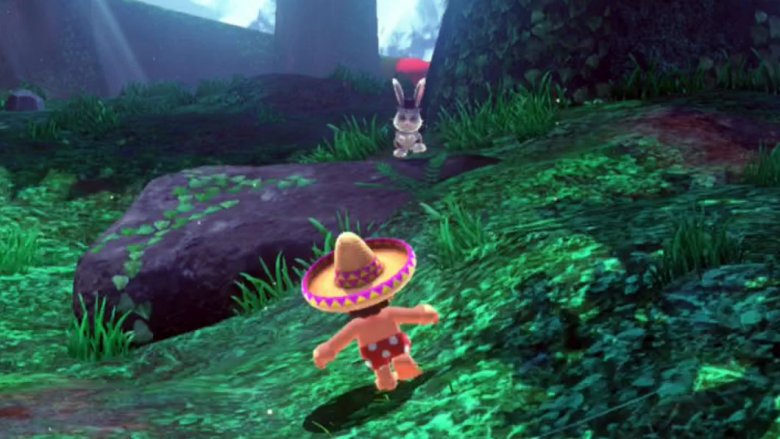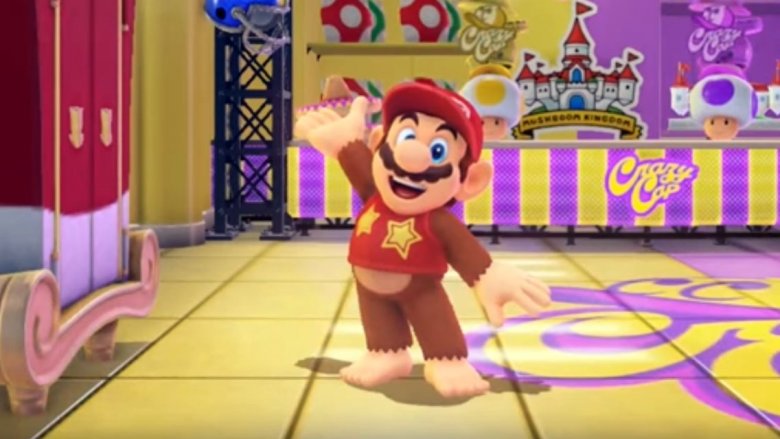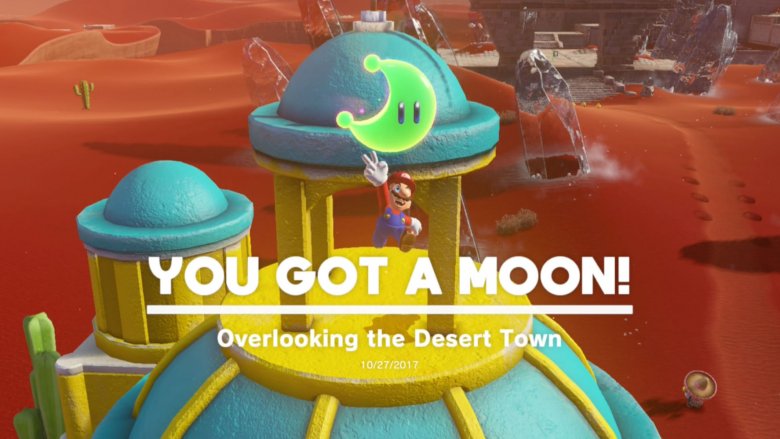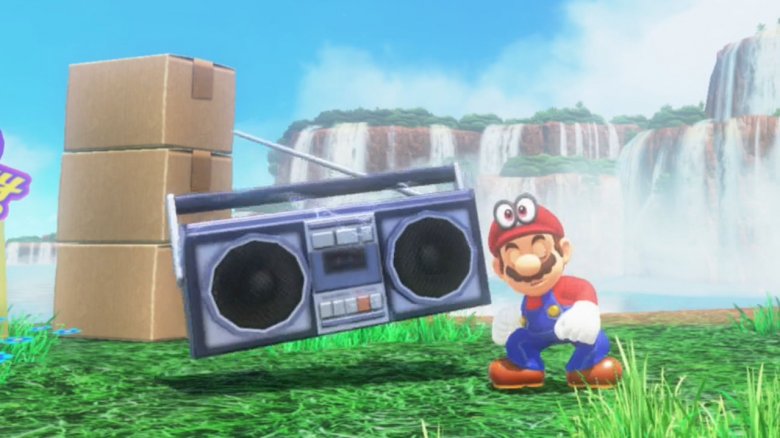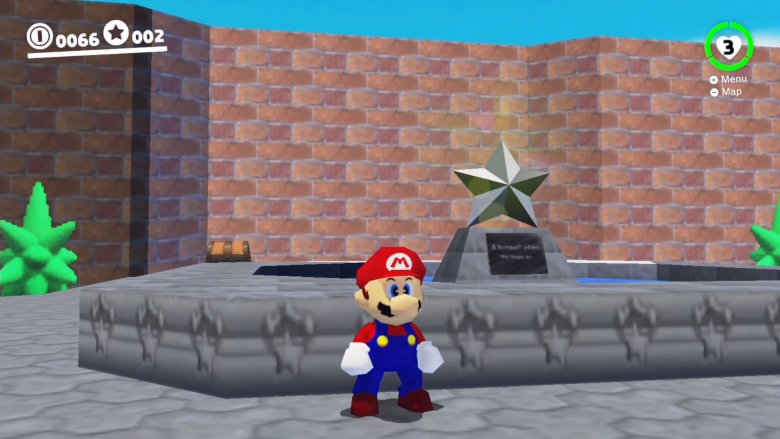Super Mario Odyssey Easter Eggs You Missed
Super Mario Odyssey isn't just Mario's biggest adventure ever, or one of the best games of 2017. It's also a giant, sprawling love letter to every facet of Mario history. Super Mario Odyssey might take Mario further than he's ever been from the Mushroom Kingdom, but the entire journey is absolutely drenched in callbacks to his long and storied past, with Easter eggs that recall his first appearance in Donkey Kong, his player-created Super Mario Maker stages, and anything and everything in between.
But unless you're a dedicated Mario fan—and we know there are some of you out there—you may not appreciate just how far into the past some of Super Mario Odyssey's Easter eggs go. That's what we're here for. Just watch out for spoilers: this list goes into some of the big surprises waiting for you. Don't worry about it too much, though. Super Mario Odyssey is absolutely huge, and we've only scratched the surface of the many secrets it has to offer.
A wardrobe full of Easter eggs
If you haven't heard yet, Super Mario Odyssey lets you buy a variety of different outfits with your hard-earned coins. That's right: if you've gotten tired of Mario's red and blue getup—or, if after 36 years, you figure he's simply due for a change of clothes—you're welcome to give Mario a long-overdue makeover.
Some of the costumes are brand new to the Mario series (we don't think that Mario's ever gone goomba-hopping in a wedding dress or a fedora before), while others have pretty obvious origins. While Luigi, Wario, and Waluigi aren't in Super Mario Odyssey (or, if they are, nobody's found them yet), their green, yellow, and purple outfits are all available for purchase. Similarly, Mario's "Classic Suit" makes his overalls red and his shirt blue, just like the clothes he wore in the very first Super Mario Bros. (blue overalls didn't become the official standard until Super Mario Bros. 3).
Many of Mario's other alternate outfits, however, are fairly deep cuts from Super Mario history, and you won't recognize them unless you're a diehard fan. The "Chef Suit" recalls Mario's days baking in Yoshi's Cookie. The safari-ready "Explorer Suit" is a nod to the Game Boy puzzler Mario's Picross, while the "Poncho Costume" resembles Mario's duds in the Game Boy edition of Qix (as well as one of his getups in the Japanese-only anime, Super Mario Bros.: Pīchi-hime Kyushutsu Dai Sakusen!). The "Painter Outfit" is references box art for the Super Nintendo title Mario Paint, the patriotic "Golf Outfit" is from Open Tournament Golf, while the "Aviator Outfit" and accompanying cap look like the clothes Mario wears in his first portable outing, Super Mario Land, during that game's shoot 'em up plane levels.
Japan-only Easter eggs
The costumes listed above aren't the only outfits in Super Mario Odyssey that recall classic Mario looks, although you may not catch some of the references unless you happen to be very familiar with Mario's Japanese heritage.
For example, the "Mechanic Outfit" is borrowed from Famicom Grand Prix II: 3D Hot Rally, a Japan-only racing game for the Nintendo Entertainment System. Mario and Luigi wear the outfit on the game's box art. While it's allegedly a solid racing game, it never made its way west. Not only was Famicom Grand Prix II exclusive to the Family Computer Disk System, which was never released in America, but Nintendo of America executives didn't think that the game was cool enough to sell in the USA (director Kazunobu Shimizu took those criticisms personally, too, and funneled his rage into his next racing game, the Super Nintendo launch title F-Zero).
Mario's "Fashionable Outfit"—which, to our untrained eyes, is more gaudy than it is truly fashionable—isn't as old of a reference, but that doesn't make it any less obscure. In 2014, when Nintendo released its souped-up version of the 3DS portable, the New 3DS, it launched a Japanese advertising campaign starring singer Kyary Pamyu Pamyu and a full roster of Nintendo characters. During the ad, Kyary Pamyu Pamyu's music gives Nintendo's classic characters brand new clothes. Link gets a dapper green tuxedo, Pikachu dresses like a king, and Mario wears the spotted shorts, striped shirt, and plaid undershirt that make the "Fashionable Outfit" so, ahem, unique.
Celebrating Super Mario Maker
In 2015, Nintendo rolled out the last 2D Mario game that anyone would ever need. Dubbed Super Mario Maker, the new title flipped the script and let players design and share their own Mario levels for the first time (at least in an official context). Despite appearing on the underperforming Wii U, Super Mario Maker sold over a million copies, earned a stripped-down 3DS spinoff, and boasts over 7.2 million levels of varying quality for Mario fans to enjoy. By any measure, that's a hit—and one that should keep fans and amateur game designers busy for years to come.
So, naturally, Nintendo put a few carefully-placed Super Mario Maker Easter eggs inside Super Mario Odyssey. Most obviously, Mario's yellow and red "Builder Helmet and Outfit," which can be purchased in New Donk City's hat shop, is the same costume on Super Mario Maker's box art. If you're hunting for all of Super Mario Odyssey's Power Moons, you'll want to pick it up, too—donning the construction-worker themed duds lets Mario pass for a New Donk City building inspector, unlocking a path to a few more.
Super Mario Odyssey's other Mario Maker Easter egg is a little more subtle. In some levels, you'll run across 8-bit pictures of Mario and Princess Peach dressed in cat outfits. While the cat suit first appeared in the Wii U's Super Mario 3D World, the sprites themselves are from Super Mario Maker, appearing as one of the costumes that Mario can wear when he touches a Mystery Mushroom. In order to unlock the costumes in Super Mario Maker, you'll need to clear a special event. In Super Mario Odyssey, the sprites serve a different purpose: hit them with Cappy, Mario's new hat-like friend, and you'll get a small health boost.
Super Mario 64, evolved
Super Mario Odyssey owes more to Super Mario 64 than any other Mario game. Unlike other Super Mario titles, which force players along predetermined paths, both Odyssey and Mario 64 drop players into wide open worlds and force them to hunt for collectibles if they want to make any progress. Platforming is still Mario's bread and butter, but both of those games focus more on exploration than mechanical challenges. That's what makes them so special.
But Super Mario 64 came out all the way back in 1996, meaning that there's a whole generation of Nintendo fans who haven't played Mario's first 3D adventure, and aren't going to get some of Super Mario Odyssey's more subtle references. Dorrie, the goggles-wearing Loch Ness Monster-like creature who floats around the Lake Kingdom, made his Super Mario debut in Super Mario 64, in which players could ride him around in order to discover new areas (in Super Mario Odyssey, he's got a Power Moon hiding on his back).
In the Wooded Kingdom, Mario needs to chase down some terrified rabbits, who flee when the plumber approaches. If that seems familiar to you, you're probably thinking of a series of similar rabbit-based chases that take place in Princess Peach's basement in Super Mario 64. Finally, while Mario hops, jumps, and stomps his way through various kingdoms, he runs across paintings that transport him to other worlds—and hidden Power Moons. That's a pretty clear reference to Super Mario 64's hanging portraits, which serve as the gateways to that game's exotic levels.
And that's just the tip of the iceberg—but we'll get to the rest in a bit.
All Kong, all the time
Most Mario fans know that Nintendo's mascot first appeared in the company's 1981 hit arcade game Donkey Kong, in which the mustachioed construction worker (he wouldn't become a plumber until 1983's Mario Bros.) had to rescue his girlfriend, Pauline, from the titular ape. Nearly 40 years after Donkey Kong's debut, Super Mario Odyssey pays homage to Mario's roots in a big, big way. While Donkey Kong doesn't appear in the game, New Donk City, arguably the most popular level in Super Mario Odyssey, is one giant tribute to the ape and his supporting cast.
Some of the nods are pretty obvious. Pauline, Mario's former flame, has been upgraded from a typical damsel in distress to New Donk City's beloved mayor (she also seems to have put Mario in the rear view mirror—while she clearly knows who he is, she doesn't reference their romantic past during the game). New Donk City is also full of moving girders, and intrepid explorers will find wooden barrels—you know, just like Donkey Kong used to throw—scattered around the city. New Donk City's streets are named after characters from the Donkey Kong Country series, including relatively obscure ones like Donkey Kong's animal mounts Rambi and Rattly (Cranky Kong, who is canonically the original Donkey Kong, gets his own avenue as well).
There's more. After fighting off some of Bowser's minions, recruiting a band, and restoring power to New Donk City, Pauline invites Mario to participate in New Donk City's annual festival, which he does by navigating a 2D remake of the original Donkey Kong game. New Donk City license plates read "1981-ND," referring to Donky Kong's release date. Using the Diddy Kong amiibo, players can unlock the "Diddy Kong Outfit," which puts Mario's head on Donkey Kong's sidekick's fuzzy body (it's a little weird). Finally, Super Mario Odyssey's jazzy title track, "Jump Up, Super Star!"—which is performed by Pauline herself—uses the original Donkey Kong music as a backing melody.
You found a Star—or a Shine, or a Power Moon!
Every time Mario finds a Power Moon, Super Mario Odyssey's main collectible, Mario celebrates with a victory pose. Given that the game has over 900 Power Moons to hunt down, you're going to get very familiar with the sequence very, very quickly.
But, if you watch closely, you might notice that Mario's post-Moon celebrations don't all look the same. More specifically, Mario doesn't always have his hand in the same position when he poses for the camera. Sometimes, he puts up two fingers, making a "V for victory" sign. Sometimes, he triumphantly pumps his fist in the air. Occasionally, he keeps his hand open, as if presenting the Power Moon to the player for approval.
Unsurprisingly, there's a little bit of history behind each one of those poses. See, each one comes from one of Mario's previous 3D adventure games. The split-fingered V-sign is what Mario does after he finds a Star in Super Mario 64. The open-handed pose comes from Super Mario Sunshine, and appears after Mario locates one of Isle Delfino's sun-shaped Shines. Finally, the fist pump hails from the two Super Mario Galaxy games, in which Mario took to the skies to hunt down Power Stars in low-gravity environments. It's a small touch, but goes a long way toward honoring Super Mario Odyssey's predecessors—after all, Mario wouldn't be where he is without 'em.
Toe-tapping tunes and sound effects
While Super Mario Odyssey is full of visual nods to the series' past, if you're playing with the sound off, you're missing out on half the fun. Yes, Super Mario Odyssey has its own orchestral soundtrack—and it is glorious—but the game is also full of auditory callbacks to past Super Mario games, and given its scope, we'd expect nothing less.
For example, in New Donk City and a few other levels, Mario runs across boom boxes that pump out smooth jazzy covers of classic Mario tracks, including Super Mario Bros.' well-known theme song. Meanwhile, if you use Cappy to possess the Maoi Statues in the desert-like Sand Kingdom, you'll notice that they hum to themselves while they're wearing their platform-revealing shades. Listen carefully, and you'll be able to identify snippets of past Super Mario soundtracks, including the Super Mario Bros. theme, the ending songs from Super Mario Bros. and Super Mario World, and a few others.
The Super Mario Odyssey menu screen hides a couple of Easter eggs, too. When you pause the game, it plays one half of the noise that Super Mario Bros. plays when Mario nabs a 1-UP mushroom. Select "Continue," and the second half sounds. If you pause and unpause the game fast enough, you'll hear the entire effect. Navigating the menu also reveals a hidden version of the Comet Observatory theme from Super Mario Galaxy, too, as long as you choose everything in the right order.
Return to the Mushroom Kingdom
Super Mario Odyssey is a big game with lots to do and many, many Power Moons to find, and most people probably haven't beaten it yet. Of course, as with most Mario games, beating Bowser is just the beginning. Once you defeat King Koopa and free Princess Peach from her involuntary nuptials, the real challenge gets started. Not only is every world flooded with a new set of Power Moons to hunt down once the game "ends" (and there are probably a few old ones still lurking around, too), but Mario can access a few new kingdoms—including one that looks very, very familiar.
That's right: in Super Mario Odyssey, you'll return to the Mushroom Kingdom, home of Peach's Castle in Super Mario 64. And, just like before, Mario's home base is absolutely full of things to do. The Mushroom Kingdom has 104 Power Moons to discover—some of which you'll find by performing platforming challenges, and others that unlock achievement-style for completing specific tasks—which is just under Super Mario 64's 120. You can access new challenges by hopping into paintings, find Yoshi hiding on the castle grounds, and even discover a few rooms that look exactly like their 64-bit counterparts.
In addition, in a fun nostalgic throwback, the Mushroom Kingdom's Power Moons look like Super Mario 64's bright yellow stars, and while you're there you can purchase the "Mario 64 Cap and Suit," which return Mario to his blocky Nintendo 64-style look. Princess Peach may not be around—after Super Mario Odyssey's conclusion, she decides to travel to the game's other kingdoms on a sightseeing tour—but it doesn't really matter. After all this time, it's just good to be home.

